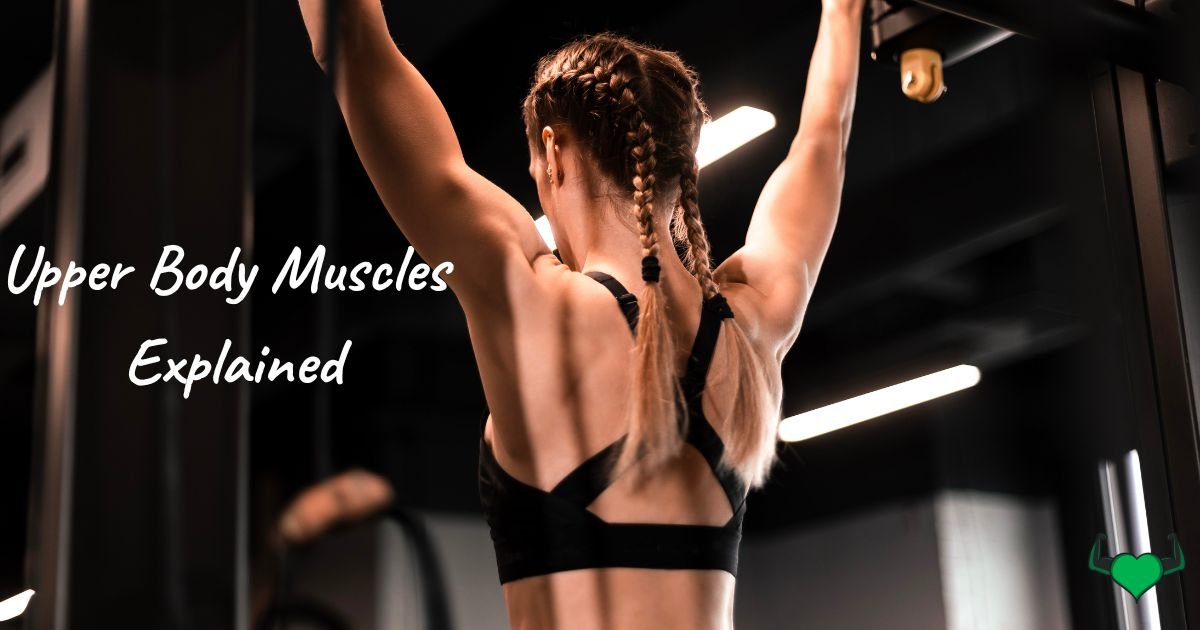Understanding and developing your upper body muscles is crucial for both functional strength and aesthetic appearance. The upper body muscles play a vital role in nearly every movement you perform daily, from lifting groceries to typing on your computer. By focusing on strengthening these muscles, you can improve your overall health, enhance your athletic performance, and maintain a balanced physique.
The upper body muscles include a range of muscle groups such as the pectorals, deltoids, trapezius, latissimus dorsi, biceps, and triceps. Each of these upper body muscles has a specific function, contributing to the coordinated movements of your arms, shoulders, and chest. Strengthening these muscles not only helps in performing daily tasks with ease but also prevents injuries and improves posture.
In this blog post, we will delve into the anatomy of upper body muscles, discussing the major muscle groups and their functions. We will also explore the importance of strengthening upper body muscles, outlining the benefits that go beyond mere physical appearance. Additionally, we will provide a comprehensive list of effective exercises tailored to target each of these upper body muscles. By the end of this post, you will have a clear understanding of how to develop a balanced and efficient workout plan to enhance your upper body strength.
Stay tuned as we break down the complex structure of the upper body muscles, offering insights and tips to help you achieve your fitness goals. Whether you are a beginner looking to start your fitness journey or an experienced athlete aiming to optimize your upper body training, this guide will serve as a valuable resource.
This website may contain affiliate links. If you make a purchase through these links, I may earn a commission at no extra cost to you. Thank you for supporting this site.
Table of Contents
Anatomy of Upper Body Muscles
Understanding the anatomy of upper body muscles is essential for designing effective workout routines and achieving your fitness goals. The upper body muscles consist of several major muscle groups, each playing a unique role in movement and strength. Here, we’ll break down the key upper body muscles, their locations, and functions.
1. Pectoral Muscles
The pectoral muscles, commonly known as the “pecs,” are located in the chest. These upper body muscles are crucial for pushing movements. The pectoralis major, the larger of the two, covers most of the chest and is responsible for movements like pushing, lifting, and rotating the arm. The pectoralis minor, lying underneath, assists in stabilizing the shoulder blade.
Key Exercises:
- Bench Press
- Push-Ups
- Chest Flyes
2. Deltoid Muscles
The deltoid muscles form the rounded contour of your shoulders. These upper body muscles are divided into three parts: anterior (front), lateral (side), and posterior (rear) deltoids. They are essential for shoulder movements and lifting actions.
Key Exercises:
- Overhead Press
- Lateral Raises
- Front Raises
3. Trapezius Muscles
The trapezius muscles, or “traps,” extend from the neck to the mid-back. These upper body muscles help move, rotate, and stabilize the shoulder blades and support arm movements.
Key Exercises:
- Shrugs
- Upright Rows
- Face Pulls
4. Latissimus Dorsi
The latissimus dorsi, or “lats,” are large muscles located on the back. These upper body muscles are crucial for pulling movements and are involved in extending, adducting, and rotating the arm.
Key Exercises:
- Pull-Ups
- Lat Pulldowns
- Bent Over Rows
5. Biceps and Triceps
The biceps and triceps are prominent upper body muscles in the arms. The biceps brachii, located at the front of the upper arm, are responsible for elbow flexion and forearm supination. The triceps brachii, located at the back of the upper arm, are responsible for elbow extension.
Key Exercises:
- Bicep Curls
- Tricep Extensions
- Hammer Curls
6. Other Muscles
Other important upper body muscles include the rhomboids, serratus anterior, and forearms. The rhomboids, located between the shoulder blades, help retract the scapula. The serratus anterior, located along the side of the rib cage, assists in the movement of the scapula. The forearm muscles are crucial for grip strength and wrist movements.
Key Exercises:
- Dumbbell Rows (Rhomboids)
- Serratus Punches (Serratus Anterior)
- Wrist Curls (Forearms)
By understanding the anatomy of these upper body muscles, you can better target each muscle group in your workouts, ensuring balanced development and improved overall strength. In the next section, we will discuss the importance of strengthening these upper body muscles and the various benefits it provides.
Importance of Strengthening Upper Body Muscles
Strengthening upper body muscles is crucial for overall health, functionality, and physical performance. By focusing on these muscles, you can reap a multitude of benefits that enhance both your daily life and athletic pursuits. Let’s explore why it is essential to strengthen upper body muscles.
1. Functional Benefits
Upper body muscles are involved in nearly every daily activity. From lifting groceries to typing on a keyboard, strong upper body muscles ensure that you can perform these tasks efficiently and without strain. Improved upper body strength enhances your ability to push, pull, lift, and carry objects, making everyday activities easier and less tiring. Additionally, strong upper body muscles contribute to better posture, reducing the risk of back and shoulder pain.
2. Health Benefits
Strengthening upper body muscles offers numerous health benefits. Strong muscles increase your metabolic rate, helping you burn more calories even at rest. This can aid in weight management and reduce the risk of obesity-related conditions. Furthermore, upper body muscle strength supports cardiovascular health by improving circulation and reducing the strain on your heart during physical activities. Enhanced muscle strength also promotes bone density, which is crucial in preventing osteoporosis and fractures.
3. Athletic Performance
For athletes, strong upper body muscles are essential for peak performance. Whether you are a runner, swimmer, or basketball player, upper body strength contributes to better speed, power, and endurance. For example, runners benefit from strong arm swings that help propel them forward, while swimmers rely on upper body muscles for powerful strokes. Strengthening upper body muscles also helps prevent injuries by providing stability and support to the joints, reducing the likelihood of strains and sprains.
In summary, strengthening upper body muscles is vital for functional efficiency, health improvements, and athletic excellence. By focusing on building these muscles, you can enhance your daily life, support your overall health, and reach new heights in your physical performance. In the next section, we will discuss effective exercises that target upper body muscles, helping you to develop a comprehensive workout plan.
Effective Exercises for Upper Body Muscles
Strengthening upper body muscles requires a combination of compound and isolation exercises that target different muscle groups. Here, we will outline some of the most effective exercises for developing upper body muscles, ensuring you have a well-rounded and comprehensive workout routine.
1. Compound Exercises
Compound exercises are multi-joint movements that engage multiple muscle groups simultaneously, making them highly effective for building upper body muscles.
Bench Press: The bench press is a classic exercise that targets the pectoral muscles, deltoids, and triceps. It is performed by lying on a bench and pressing a barbell or dumbbells away from your chest.
Overhead Press: The overhead press works the deltoids, trapezius, and triceps. Stand with your feet shoulder-width apart, holding a barbell or dumbbells at shoulder height, and press them overhead until your arms are fully extended.
Rows: Rows are excellent for targeting the latissimus dorsi, trapezius, and rhomboids. Bent-over rows are performed by bending at the waist and pulling a barbell or dumbbells towards your abdomen.
Pull-Ups: Pull-ups primarily target the latissimus dorsi, biceps, and forearms. Hang from a pull-up bar with an overhand grip and pull your body upward until your chin clears the bar.
2. Isolation Exercises
Isolation exercises focus on specific upper body muscles, helping to develop strength and definition in particular areas.
Bicep Curls: Bicep curls isolate the biceps brachii. Stand with a dumbbell in each hand, palms facing forward, and curl the weights towards your shoulders.
Tricep Extensions: Tricep extensions target the triceps brachii. Hold a dumbbell with both hands above your head, and extend your arms to lower the weight behind your head, then lift it back up.
Lateral Raises: Lateral raises focus on the lateral deltoids. Stand with a dumbbell in each hand at your sides, and lift your arms out to the sides until they are parallel to the ground.
3. Bodyweight Exercises
Bodyweight exercises are convenient and effective for strengthening upper body muscles without the need for equipment.
Push-Ups: Push-ups engage the pectorals, deltoids, triceps, and core. Start in a plank position and lower your body until your chest nearly touches the floor, then push back up.
Dips: Dips work the triceps, pectorals, and shoulders. Use parallel bars or the edge of a bench, lower your body by bending your elbows, then push back up.
Planks: Planks strengthen the core, shoulders, and upper body muscles. Hold a plank position on your elbows and toes, keeping your body straight and tight.
4. Tips for Safe and Effective Workouts
To maximize the benefits of these exercises and ensure the safe development of upper body muscles, follow these tips:
Proper Form: Maintaining correct form is crucial to avoid injuries and ensure that you are effectively targeting the intended upper body muscles. Consider working with a trainer to learn the proper techniques.
Warm-Up and Cool-Down: Always start your workout with a warm-up to prepare your muscles and joints for exercise. Finish with a cool-down to aid recovery and reduce muscle soreness.
Progressive Overload: Gradually increase the weight, resistance, or intensity of your exercises to continually challenge your upper body muscles and promote growth.
By incorporating these effective exercises into your routine, you can build strong, well-defined upper body muscles. In the next section, we will discuss common mistakes to avoid when training upper body muscles, ensuring you get the most out of your workouts.
Common Mistakes and How to Avoid Them
When training upper body muscles, it’s easy to fall into certain pitfalls that can hinder progress and increase the risk of injury. Being aware of these common mistakes and knowing how to avoid them can help you achieve better results and maintain your upper body muscles more effectively.
1. Overtraining and Undertraining
One of the most common mistakes in developing upper body muscles is overtraining or undertraining. Overtraining occurs when you work your upper body muscles too frequently without allowing adequate recovery time, leading to muscle fatigue and injury. Undertraining, on the other hand, happens when you do not provide enough stimulus for muscle growth.
How to Avoid:
- Balance Your Routine: Ensure your workout routine includes both upper body and lower body exercises, allowing each muscle group adequate recovery time.
- Follow a Schedule: Stick to a structured workout plan that targets upper body muscles 2-3 times per week.
- Rest and Recover: Incorporate rest days and ensure you get enough sleep to allow your muscles to repair and grow.
2. Poor Form
Using improper form is a significant mistake that can prevent you from effectively targeting your upper body muscles and increase the risk of injury. Poor form often results from lifting too heavy weights or not paying attention to technique.
How to Avoid:
- Focus on Technique: Prioritize proper form over lifting heavier weights. Ensure you perform each exercise correctly to maximize muscle engagement.
- Use Mirrors: Utilize mirrors to monitor your form during exercises, making adjustments as needed.
- Seek Guidance: Consider working with a trainer or watching instructional videos to learn the correct techniques for each exercise.
3. Imbalanced Training
Focusing too much on one muscle group while neglecting others can lead to muscular imbalances, which can affect posture and increase the risk of injury. For example, overemphasizing the chest muscles while neglecting the back muscles can cause rounded shoulders and back pain.
How to Avoid:
- Full-Body Workouts: Incorporate a variety of exercises that target all major upper body muscles, including the chest, back, shoulders, and arms.
- Equal Attention: Give equal attention to both pushing and pulling exercises to ensure balanced development of upper body muscles.
- Regular Assessment: Regularly assess your strength and development to identify and correct any imbalances.
4. Inadequate Recovery
Inadequate recovery between workouts can impede muscle growth and increase the risk of injury. Recovery is crucial for repairing and building upper body muscles after intense workouts.
How to Avoid:
- Rest Days: Include rest days in your workout routine to allow your upper body muscles to recover.
- Hydration and Nutrition: Stay hydrated and consume a balanced diet rich in protein, carbohydrates, and healthy fats to support muscle recovery and growth.
- Stretching and Foam Rolling: Incorporate stretching and foam rolling into your routine to improve flexibility and reduce muscle soreness.
By being aware of these common mistakes and implementing strategies to avoid them, you can ensure safe and effective development of your upper body muscles. Proper training, balanced routines, and adequate recovery are key to achieving your fitness goals. In the next section, we will discuss how to create a balanced upper body workout plan that targets all major muscle groups effectively.
Creating a Balanced Upper Body Workout Plan
Developing a balanced upper body workout plan is essential for effectively strengthening and toning your upper body muscles. A well-rounded plan ensures that all major muscle groups are targeted, reducing the risk of imbalances and promoting overall muscular development. Here’s how you can create an effective and balanced upper body workout plan.
1. Assessing Your Fitness Level
Before you start, it’s important to assess your current fitness level. Understanding your strengths and weaknesses helps in tailoring a workout plan that suits your needs and goals.
How to Assess:
- Fitness Tests: Perform basic fitness tests like push-ups, pull-ups, and plank holds to gauge your upper body strength and endurance.
- Identify Goals: Determine what you aim to achieve, whether it’s building muscle mass, increasing strength, or improving endurance.
2. Setting Goals
Setting clear, achievable goals is crucial for staying motivated and tracking progress. Goals can range from increasing the number of reps in a specific exercise to lifting a certain amount of weight.
Types of Goals:
- Short-Term Goals: E.g., performing 10 more push-ups within a month.
- Long-Term Goals: E.g., increasing your bench press weight by 20 pounds over six months.
3. Sample Workout Plan
A balanced upper body workout plan should include a mix of compound and isolation exercises that target all major upper body muscles. Here’s a sample workout plan:
Day 1: Chest and Triceps
- Warm-Up: 5-10 minutes of light cardio
- Bench Press: 4 sets of 8-12 reps
- Push-Ups: 3 sets of 12-15 reps
- Tricep Dips: 3 sets of 10-12 reps
- Chest Flyes: 3 sets of 12-15 reps
- Tricep Extensions: 3 sets of 12-15 reps
Day 2: Back and Biceps
- Warm-Up: 5-10 minutes of light cardio
- Pull-Ups: 4 sets of 8-12 reps
- Bent Over Rows: 4 sets of 8-12 reps
- Bicep Curls: 3 sets of 12-15 reps
- Lat Pulldowns: 3 sets of 12-15 reps
- Hammer Curls: 3 sets of 12-15 reps
Day 3: Shoulders and Core
- Warm-Up: 5-10 minutes of light cardio
- Overhead Press: 4 sets of 8-12 reps
- Lateral Raises: 3 sets of 12-15 reps
- Front Raises: 3 sets of 12-15 reps
- Planks: 3 sets, 1 minute each
- Russian Twists: 3 sets of 20 reps
Day 4: Rest or Active Recovery
- Light cardio, stretching, or yoga
4. Progress Tracking and Adjustments
Monitoring your progress and making necessary adjustments to your workout plan ensures continuous improvement and avoids plateaus.
How to Track Progress:
- Workout Journal: Keep a journal to record your workouts, weights, reps, and sets.
- Regular Assessments: Perform fitness tests regularly to measure improvements in your upper body muscles.
- Adjusting Intensity: Gradually increase the weight, reps, or sets to challenge your upper body muscles continuously.
By following a balanced upper body workout plan, you can effectively target all major upper body muscles, promoting strength, endurance, and muscle growth. Remember to combine your workout routine with proper nutrition and adequate rest for optimal results. In the next section, we will conclude with a summary of key points and a call to action to incorporate upper body muscle training into your fitness regimen.
Conclusion
Strengthening upper body muscles is essential for enhancing overall physical health, improving daily functionality, and achieving athletic performance. Understanding the anatomy of upper body muscles helps you to target each muscle group effectively, ensuring balanced development and reducing the risk of injury.
We explored the various upper body muscles, including the pectorals, deltoids, trapezius, latissimus dorsi, biceps, triceps, and smaller muscles like the rhomboids and serratus anterior. Recognizing the importance of these muscles highlights the benefits of upper body strength, such as better posture, increased metabolic rate, and enhanced athletic performance.
Effective exercises for upper body muscles include a mix of compound movements like bench presses and pull-ups, isolation exercises like bicep curls and tricep extensions, and bodyweight exercises like push-ups and planks. Incorporating these exercises into your routine helps ensure comprehensive development of upper body muscles.
We also discussed common mistakes to avoid when training upper body muscles, such as overtraining, poor form, imbalanced training, and inadequate recovery. By being mindful of these pitfalls and implementing strategies to avoid them, you can optimize your workout effectiveness and safety.
Creating a balanced upper body workout plan involves assessing your fitness level, setting achievable goals, and incorporating a variety of exercises that target all major upper body muscles. Tracking your progress and making necessary adjustments ensures continuous improvement and helps you achieve your fitness objectives.
Incorporating upper body muscle training into your fitness regimen can transform your physical capabilities and overall well-being. Start today by integrating these exercises and tips into your workout routine, and experience the benefits of strong, well-developed upper body muscles. If you have any questions or want to share your experiences, feel free to leave a comment. Let’s build a stronger, healthier you together!




